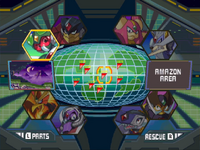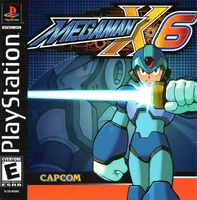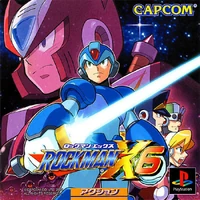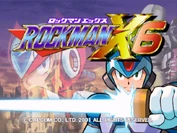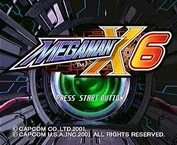Mega Man X6, known as Rockman X6 (ロックマンX6 Rokkuman Ekkusu Shikkusu) in Japan, and often shortened to MMX6, or just X6,[2] is the sixth game in the Mega Man X series and the final title in the series to be released for the Sony PlayStation. Both Mega Man X5 and Mega Man X6 were released after the launch of the PlayStation 2, so after the development and release of Mega Man X6, Capcom made the transition to the PlayStation 2. Mega Man X6 was developed and released on the original PlayStation mainly to reach out to a broader audience. The game was later re-released as part of the Mega Man X Collection, and it was released on the PlayStation Network as part of the PSOne classics in Japan on July 8, 2015. It was then re-released on Mega Man X Legacy Collection 2 on July 24, 2018 in North America and Europe, and was released two days later in Japan.
Series artist and producer Keiji Inafune was not involved in the game's production, as he had originally intended for the series to end with Mega Man X5.[3][4] As such, X6 caused a massive change of plans in both the Mega Man X and Mega Man Zero series.
Story[]
Note: The story of Mega Man X6 follows the best ending of Mega Man X5. Though Eurasia was 86% destroyed and damage was mitigated, its debris still crashed on Earth. Zero was severely damaged and separated from X in the battle with Sigma, making X believe Zero perished. X retrieves his Z-Saber and wields it to honor him.
Three weeks after the crash of the Eurasia colony in Mega Man X5, the Earth's surface was still badly damaged by the debris and the Sigma Virus, and humans were forced to live underground to escape the pollution. Reploids stayed on the surface to attempt to make it livable once again. With the world so ravaged, Maverick activity fell into memory; the Maverick Hunters instead helped restore the world.
Gate, a reclusive Reploid scientist who was once a colleague of Alia, investigates the crash site of Eurasia and finds an unusual piece of debris that drives him mad. Soon after, a strange set of Maverick outbreaks occur. When X is dispatched and defeats D-1000, he sees a purple phantom that resembles Zero. A powerful Reploid named High Max appears and claims to be hunting the Zero Nightmare; when X presses him for answers, High Max overcomes him with his invincible powers before letting him off with a warning.
A scientist named Isoc makes an announcement that the ghost of Zero, Zero Nightmare, is behind this new Nightmare that is causing Mavericks. He sends eight Nightmare Investigators to areas infected by the Nightmare to uncover the mysteries surrounding it and delete Zero's ghost, with High Max leading the mission. Isoc also calls for volunteers to help, resulting in droves of Reploid volunteers entering the areas too. X chooses to investigate the suspected areas to research the Nightmare, defeat the Mavericks, and rescue the Reploid volunteers suffering from the Nightmare.
Each of the eight Nightmare Investigators proves hostile towards X, forcing him to destroy them - additionally, Alia recognizes them as previously deceased Reploids who were creations of her old colleague Gate. X also destroys the Zero Nightmare and reunites with the real Zero, who was believed to have been destroyed. Signas is reluctant to ask Zero's help as he had just returned, but due to the crisis, Zero helps X.
After defeating the Nightmare Investigators, Gate calls the Hunters to reveal he is the mastermind behind the entire situation: Isoc, High Max, the Nightmare, all of it. Gate states his plans to use the Nightmare to subjugate all "low-grade" Reploids and build his own world of advanced Reploids, before challenging X and Zero to a duel in his hidden laboratory. In the laboratory, Gate also reveals that he created both the Nightmare and High Max by analyzing Zero's DNA, which is what he found at Eurasia's crash site. X and Zero defeat High Max and finally Gate; Isoc was found lifeless in a manner similar to Erasure.
Upon Gate's defeat, he reveals he had revived Sigma as a last resort. Sigma states that he didn't need his help, and attacks Gate before retreating. X and Zero rush to stop the partially-reconstructed Sigma and battle him, and although he is not fully complete, he is immensely powerful. In the end, the Hunters prove victorious, defeating Sigma and recovering Gate's body from the wreckage of his lab. The Nightmare is over, and the Hunters promise to build a better future.
In Zero's ending, Zero decides that his body is too dangerous and chooses to seal himself away for a century of research. This event occurs at the end of the Mega Man X timeline, leading into the Mega Man Zero series.
Gameplay[]
Mega Man X6 is identical to its predecessor in terms of general gameplay, traversing through dangerous terrain while defeating a legion of enemies throughout the way. Unlike the previous two games, the player starts out the game as X. However, X has changed considerably. While he starts out with the Falcon Armor, most of its special abilities have been lost, but for a trade in, he can use Zero's Z-Saber as an alternate weapon, although he wields it with less skill and thus can only use single swings.
The Nightmare pervades each of the game's eight stages. This manifests in a variety of ways throughout the stages as the Nightmare Phenomenon, which makes the stages more difficult by adding additional hazards. It also manifests as Nightmare Viruses, floating DNA-like enemies that can prove troublesome. They attempt to infect Injured Reploids (whom the player must save in order to obtain bonuses and upgrades) to drive them insane. Defeating a Nightmare Virus yields a Nightmare Soul, which can be used to increase how many parts can be equipped to a character. A Soul must be retrieved quickly before the Nightmare revives itself where it will not yield it a second time.
Each stage also contains an Another Route (アナザールート Anazā Rūto)[5] which can be accessed through a secret blue portal. This sends the player to a new part of the stage that contains a secret Another Boss ( アナザーボス Anazā Bosu).[5] First it is Zero Nightmare, whose defeat unlocks Zero as a playable character. While he has not changed much, Zero's Z-Saber has a somewhat longer reach than X's and its appearance has changed into a straight sword. His Z-Buster also fires faster but can only be fired on the ground as usual. This is also the first game in the series that Zero can double-jump without having gained a special technique first. Following Zero Nightmare's defeat, High Max takes his place; overcoming him unlocks the Secret Lab stages early. Finally, Dynamo takes the final spot, yielding Nightmare Souls upon defeat and allowing the player a rematch at any time.
X can gain two new armors as usual though they must be assembled before they can be utilized: The Blade Armor, which enhances X's melee potential with the Z-Saber and the Shadow Armor which ups his maneuverability and grants him immunity to spikes. One can unlock the Ultimate Armor through the use of a cheat code at the title screen.
Bosses[]
Opening Stage Bosses:
Stage Select Screen bosses:
- Zero Nightmare (first visit)
- High Max (second visit)
- Dynamo (third and later visits)
Secret Lab bosses:
- Nightmare Mother
- High Max and Gate
- Boss Rush and Sigma
Armors[]
X's armors:
- Falcon Armor - X begins the game with this armor.
- Blade Armor - Maneuverability and Z-Saber-based armor.
- Shadow Armor - Defense and stealth-based armor.
- Ultimate Armor - Accessible through a code.
Zero's armor:
- Black Zero - Accessible through a code.
Note: As only one code can be entered, it is impossible to obtain both the Ultimate Armor and Black Zero in one playthrough (or save file) without using external cheats.
Reception[]
According to the Japanese magazine Famitsu, Mega Man X6 was the seventh best-selling game in Japan during its week of release at 39,318 units sold.[6] Dengeki Online reported that Mega Man X6 sold a total of 106,980 units in Japan by the end of 2001, marking it as the 109th best-selling game of the year in the region.[7] The game eventually saw a re-release as part of the PlayStation the Best range of budget titles.[8]
Outside Japan, Mega Man X6 received mixed to positive reviews, with an average score of 68.74% on GameRankings.[9] GameSpot gave the game a 7 out of 10, saying that the game is "a disappointing effort. The nightmare system and item collecting add variety and longevity to the game, but... The graphics aren't really even up to the standards set by older games in the series, and while the music is good, there aren't any tracks that particularly stand out. Despite these shortcomings, it's still Mega Man, and the gameplay is still entertaining, making X6 an attractive package for hard-core Mega Man fans."[10] IGN gave a more positive review, an 8 out 10, stating "It's an all-new Mega Man game, yet it's still pretty much the same. There's nothing wrong with that"; they praised the soundtrack and replay value.[11]
Among the most negative reviews, Electronic Gaming Monthly gave the game a 3.5 out of 10, saying "I thought I’d sooner see Sasquatch ride a Chimera bareback through the streets than a bland series like Mega Man X last through six installments."[12] 1UP.com referred to Mega Man X6 as "sloppy" citing multiple issues within its design such as unpolished and cheap gameplay, repetitive stage elements, and high difficulty.[13]
See also[]
- List of Mega Man X6 enemies
- Mega Man X6 walkthrough
- Mega Man X6 Damage Data Chart (X)
- Mega Man X6 Damage Data Chart (Zero)
- Mega Man X6 Script (X's story)
- Mega Man X6 Script (Zero's story)
- Parts Guide
- Rescuable Reploids Guide
Gallery[]
- For this subject's image gallery, see Mega Man X6/Gallery
Cover Art[]
Screenshots[]
Videos[]
Trivia[]
- In the original Japanese version version of the game, the eight bosses' names are said by an announcer after the player selects the stage.
- Zero's sprite set was redesigned for Mega Man X6. Although his gameplay is similar to that in Mega Man X4 and Mega Man X5, his Z-Saber no longer has an arcing curve, appearing more straight during gameplay. His saber swipes move in a new pattern, and his idle pose changes his hand positions. His Z-Buster has also been improved from the previous title. Although Zero can still only fire mid-charged shots with limited range while stationary, it can now be fired in quick succession with the charge-up time reduced to near-instantaneously.
- Zero Nightmare, however, still uses Zero's old sprite set from Mega Man X5, although recolored purple.
- Zero dons a new saber in this title, as his old saber is now wielded by X. It functions like a typical lightsaber seen in the Star Wars series, and heavily resembles Sigma's saber in the first Mega Man X game.
- The color of Zero's feet is wrong and becomes white in the scene of the confrontation between Zero and Isoc.
- This is one of the few games that doesn't feature Sigma as the main villain, a first in the Mega Man X series. That honor goes to Gate, though Sigma was still included as the final boss.
- This is the first game in which the Reploids in the game could be corrupted, collected, or be missing. It was also the first to mention they could give X and Zero upgrades.
- Zero's ending in Mega Man X6 is not actually an ending of Mega Man X6; instead, it is supposedly the true ending of the entire Mega Man X series, serving as a replacement of sorts for Keiji Inafune's intended conclusion from Mega Man X5. It was never officially stated when the ending takes place, allowing two sequels (Mega Man X7 and Mega Man X8) to be made so far.[Citation needed]
- This is the first game in the Mega Man X series where most of the eight Maverick's names were not differentiated from the Japanese release for the US release.
- The rescuable Reploids in Blizzard Wolfang's stage share the names of characters from other Mega Man titles as well different Capcom franchises, such as Mega Man Legends, Street Fighter, Final Fight, Resident Evil, Devil May Cry, Rival Schools, Breath of Fire, Ace Attorney, Ghost and Ghosts and Onimusha.
- Due to a continuity error, the game's intro states that the events of Mega Man X6 took place three weeks after the events of Mega Man X5, whereas in X's ending of Mega Man X5 (if Zero does not become Maverick), it is stated that it took place three years later. Although it may represent that X's ending on X5 took place after the events of X6, thus following the ending in which X does not find Zero.
- This game is known to have a somewhat low-quality english localization. One example is Alia saying that "A High Jump Part will be help." at the beginning of Blizzard Wolfang's stage. A re-translation was planned for the Mega Man X Collection, but the changes were dropped. The lack of translation quality, copyright issues of Japanese songs used in the game, and other reasons also prevented the English versions from being released on PlayStation Network, although the script remains unchanged on "Mega Man X Legacy Collection 2".
- The area where the game's ending takes place seems to be similar to the area where Zero is discovered if the player defeats the Zero Nightmare.
- Oddly, this game has the most themes for the bosses in Gate's Laboratory stages.
- Sigma is the only boss in the game to have a Sigma/Maverick insignia on his life bar.
- If the player defeats High Max in the Nightmare Area (easily done with X's Ultimate Armor), the way to Gate's Laboratory will open regardless of how many Maverick bosses were defeated. This means the player can effectively reach the end of the game without fighting a single Maverick.
- This game and Mega Man X5 are the only games in the entire series which do not fully require the player to defeat all of the eight Mavericks to unlock the final stages.
- The opening of this game shows a detailed script between Sigma and Dynamo before the opening scene of Mega Man X5, describing Sigma's observation of the Colony to Dynamo, to the battle between X and Zero, and the aftermath of the Earth Crisis.
- Like in Mega Man X2, there seems to be a translation error where X discovered Zero. In the English version, Zero claims that he "hid himself while trying to repair himself", whereas in the original Japanese version he said no such thing, but compared his survival to X's, possibly implying that he was repaired by either the same person who repaired X or even his own creator.
- From this game to Mega Man X8, Zero has a rolling double-jump present by default.
- In the original release, and the Mega Man X Legacy Collection 2 release, the cutscenes have the original Japanese voice actors. This was dropped from the Mega Man X Collection release.
- Although the original American release retains the Japanese opening and ending vocal themes, they have been removed in the Mega Man X Legacy Collection 2 revision, with new-recorded instrumental tracks replacing them (possibly due to copyright concerns of Japanese songs), with the exception of playing the English version of the game in the Japanese release.
- Incidentally, the Mega Man X Legacy Collection 2 re-release uses the original Japanese version of the opening stage theme, rather than the slightly altered international version. It is unknown whether or not this was an oversight or if it was intentional.
- This makes Mega Man X6 the only game to not have an official English dub after Mega Man X4.
- This is one of the few games in the Mega Man X series that does not change the background music of the Stage Select screen once the final stages become accessible, the other ones being the spin-offs Mega Man Xtreme and its sequel, thus also making Mega Man X6 the only main game of the series to not have this feature.
- It is technically possible to have both X's Ultimate Armor and Black Armor Zero in the same save file, as there are conditions that allow the latter to be unlocked during gameplay. However, these requirements involve defeating the Zero Nightmare at LV4, which is triggered by collecting 5,000 Nightmare Souls; because the final stages unlock after collecting only 3,000 souls, after which the Zero Nightmare will no longer appear, it is impossible to actually meet these conditions.
- The soul requirement was actually 5,000 in the 9/28/2001 prototype build; Capcom changed this after the prototype build, probably because it would take too much time to collect 5,000 souls. Also in the 9/28/2001 prototype build, Zero Nightmare/High Max can still be fought even if the final stage is unlocked via the collection of 3000 souls.
- Sting Chameleon, Magna Centipede, Blast Hornet and Storm Eagle make a cameo appearance in this game, the former three being summoned during battle by Metal Shark Player, the latter in one of X's Special Weapons, the Metal Anchor.
- Like Mega Man X5, the original PlayStation version of Mega Man X6 is only capable of interacting with memory cards in the slot 1. That makes both games big exceptions when compared to other games released on the same platform, such as Mega Man X4, Mega Man 8, Mega Man Legends, which can read and save data in memory cards in both slots.
External links[]
- Rockman X6 official site (archive)
References[]
- ↑ Electronic Arts (Taiwan): Rockman X6 (archive)
- ↑ https://www.capcom.co.jp/rxac/about/index.html
- ↑ "I had very little to do with 'X5.' I just told the team to 'finish off the series with this title,' and left it at that. That's why the game itself has a real feel of finality to it." -Keiji Inafune, Mega Man X Official Complete Works, UDON Entertainment Corp. 2009. pg.48. Retrieved on July 13, 2011.
- ↑ "I had honestly planned to for 'X5' to be the last title in the series, but somehow I found myself with 'X6.' I feel like I owe the fans an apology, but I have to admit the series was starting to go in a direction that was out of my control. I plan to reexamine the situation and be more careful with how I handle the Mega Man name from now on." -Keiji Inafune, Mega Man X Official Complete Works, UDON Entertainment Corp. 2009. pg.56. Retrieved on July 13, 2011.
- ↑ 5.0 5.1 Point E, Rockman X6. Compendium of Rockman X. p. 88.
- ↑ IGN: The Famitsu Top 10 (11/26/01 - 12/02/01)
- ↑ IGN: Dengeki Online Top 200 of 2001
- ↑ Famitsu: 11月28日~12月26日
- ↑ GameRankings: Mega Man X6
- ↑ GameSpot: Mega Man X6 Review for PlayStation
- ↑ IGN: Mega Man X6 - PlayStation Review
- ↑ Electronic Gaming Monthly #151 (February 2002) page 172
- ↑ 1UP: Mega Mediocrity
| Mega Man X6 | |
|---|---|
| Nightmare Investigators | |
| Commander Yammark • Ground Scaravich • Blaze Heatnix • Blizzard Wolfang • Rainy Turtloid Metal Shark Player • Shield Sheldon • Infinity Mijinion | |
| Other Bosses | |
| D-1000 • Zero Nightmare • Dynamo • Nightmare Mother • High Max • Gate • Sigma | |
| X's Special Weapons | |
| Yammar Option • Ground Dash • Magma Blade • Ice Burst • Meteor Rain • Metal Anchor • Guard Shell • Ray Arrow | |
| Zero's Special Techniques | |
| Yammar Option • Sentsuizan • Shoenzan • Hyoroga • Ensuizan • Rakukojin • Guard Shell • Rekkoha | |
| Armors | |
| - X - Falcon Armor • Blade Armor • Shadow Armor • Ultimate Armor - Zero - Black Zero | |
| Stages | |
| Opening Stage • Amazon Area • Central Museum • Magma Area • North Pole Area • Inami Temple • Recycle Lab • Laser Institute • Weapon Center • Secret Lab | |
| Miscellaneous | |
| Walkthrough • Another Route • Parts • Injured Reploids • List of Enemies Damage Data Chart (X) • Damage Data Chart (Zero) • Game Script (X's story) • Game Script (Zero's story) | |

